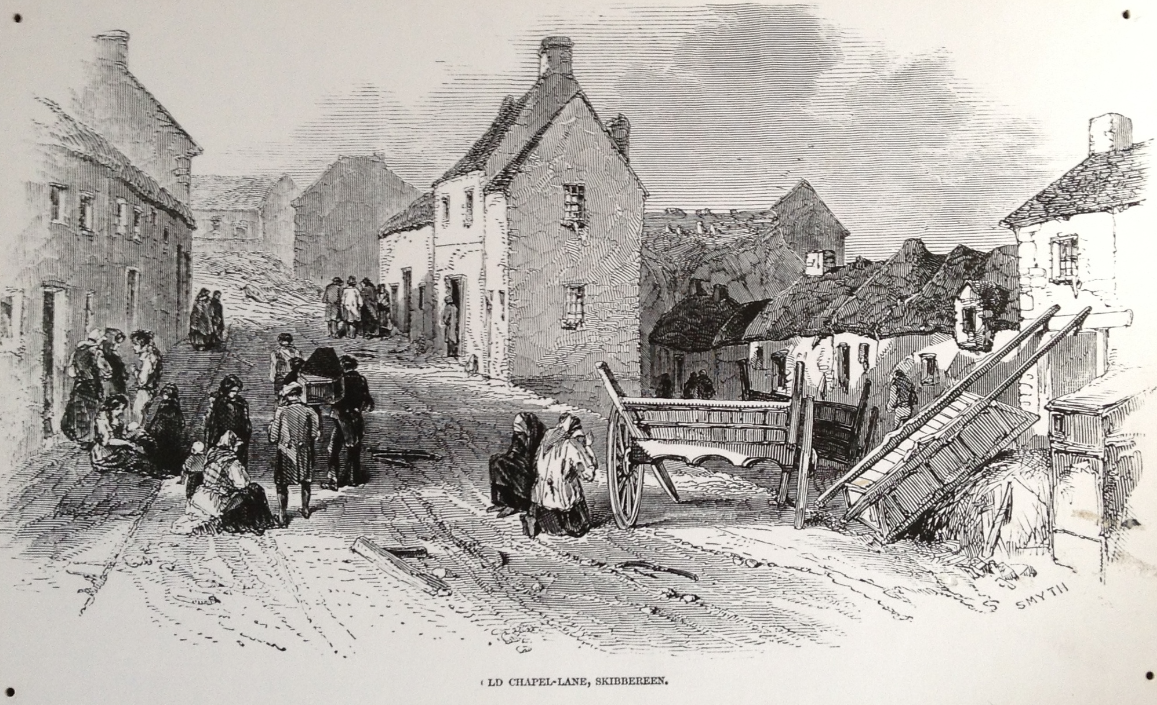MyTownMatters and the Forbes House Museum are happy to offer a series of short stories and illustrations on Ireland’s Great Famine and its connection to Milton/Boston. Part I provided background information on Forbes House Museum’s association with the Famine. Part II introduced the illustrator, James Mahony (c. 1816- c.1859), hired by the Illustrated London News to document the Great Famine.
by Robin M. Tagliaferri, FHM Executive Director
The Forbes House Museum has been collaborating since 2011 with scholars and civic groups from the United States and Ireland, researching Ireland’s Great Famine, which took place from 1845 to 1852.
The FHM Great Famine project seeks to raise awareness for the historic 1847 humanitarian voyage of Captain Robert Bennet Forbes (1804- 1889), who transported 800 tons of food and other provisions to Cork, Ireland aboard the USS Jamestown at the height of the Famine. The project will include a schedule of programs and exhibits beginning in 2015, exploring Forbes’ contribution to the relief effort through participation and membership in the New England Relief Committee, a philanthropic group of Boston business, religious and community leaders.
Over the past four years, Dr. Catherine B. Shannon, Professor Emerita of Westfield State University, has worked with the FHM as the project’s head scholar. Dr. Shannon’s research, writing and teaching in Irish studies and Irish American history are internationally recognized on both sides of the Atlantic. She is past president of the Charitable Irish and Eire Societies of Boston, and an expert on Forbes’ 1847 humanitarian voyage to Cork, Ireland.
In June 2014, Dr. Shannon traveled to Ireland of behalf of the project, meeting with government officials, scholars, and community leaders in Cork and Dublin.
Other project advisors include Dr. Mary C. Kelly, Professor of History at Franklin Pierce University, Rindge, NH and Dr. Laurence M. Geary, historian and lecturer at University College Cork, Ireland.
An illustrator and watercolorist, James Mahony (c. 1816- c. 1859), worked for the Illustrated London News from 1846-49/50. He was sent to his native west Cork, Ireland, the region most effected by the Great Famine. The printed engravings of Mahony’s illustrations brought shock to readers in England and abroad, documenting the unfolding height of the tragedy and mobilizing public opinion to action. Here we feature another of Mahony’s illustrations with his journal entry.

“Old Chapel-Lane, Skibbereen by James Mohony, Illustrated London News, 1847. The town of Bridgetown is seen in the distance to the right. This actual printed copy was displayed in the 1967 exhibition at the Forbes House Museum, “Massachusetts Help to Ireland During the Great Famine.” Notice the pin marks at the corners. FHM permanent collection.
“We next reached Skibbereen,… with perfect confidence, (I) say that neither pen nor pencil ever could portray the misery and horror, at this moment, to be witnessed in Skibbereen. We first proceeded to Bridgetown, a portion of which is shown in the right hand distance of the sketch; and there I saw the dying, the living, and the dead, lying indiscriminately upon the same floor, without anything between them and the cold earth, save a few miserable rags upon them. To point to any particular house as a proof of this would be a waste of time, as all were in the same state; and, not a single house out of 500 could boast of being free from death and fever…
After leaving this abode of death, we proceeded to High-street, or Old Chapel-lane and there found one house, without door or window, filled with destitute people lying on the bare floor; and one, fine, tall, stout country lad, who had entered some hours previously to find shelter from the piercing cold, lay here dead amongst others likely soon to follow him. The appeals to the feelings and professional skill of my kind attendants here became truly heart-rending and so distressed Dr. Donovan, that he begged me not to go into the house, and to avoid coming into contact with the people surrounding the doorway.”
The Forbes House Museum is very grateful to 02186/My Town Matters and its editor, Frank Schroth for the opportunity to submit feature articles to the public. A fourth installation in the series, “Forbes House Museum and Ireland’s Great Famine: Who Knows the Story?” will appear later this month.
Sources/Credits for this article include:
Shannon, Catherine B., Ph.D., It’s Not an Everyday Matter to See a Nation Starving: Captain Robert Bennet Forbes and the 1847 Voyage of the USS Jamestown to Cork, Ireland,” 2014 (revised)
http://viewsofthefamine.wordpress.com/illustrated-london-news/sketches-in-the-west-of-ireland/